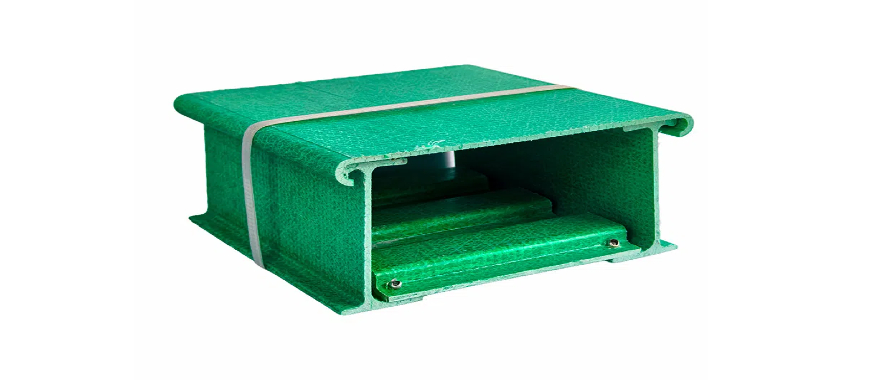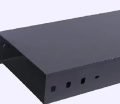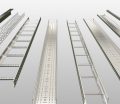
A performance cable tray provides a lightweight and flexible solution for effective cable management. Its open-mesh design ensures superior airflow and heat dissipation, making it ideal for low-voltage and data cables in both commercial and industrial environments. When durability and resistance to harsh conditions are required, an epoxy cable tray offers enhanced protection against corrosion, chemical exposure, and wear, ensuring long-term reliability. This tray type is easy to cut, shape, and install, allowing for seamless adaptation to complex layouts and custom configurations. Frequently used in telecommunications, data centers, and general electrical installations, a performance cable tray, including options like the epoxy cable tray, offers reliable support while enhancing safety and extending the lifespan of cable systems. Its versatility makes it a preferred choice for projects requiring efficient cooling, durability, and adaptability in managing modern cable networks.
How About Performance Cable Tray in Modern Systems?
The performance cable tray has become an essential component in various industrial, commercial, and residential environments. These systems are designed to support and organize cables efficiently while maintaining optimal performance under different conditions. Below, we delve into the critical aspects of the performance cable tray, including its components, benefits, and applications.
Benefits of Using Performance Cable Tray
Performance cable tray systems provide numerous benefits, making them a preferred choice for cable management. Some of the most notable advantages include:
- Enhanced Safety:
Performance cable tray systems are designed to minimize the risk of electrical hazards. They provide structured pathways for cables, reducing the chances of entanglement, overheating, or short circuits. - Easy Maintenance:
Regular inspections and repairs are simplified with performance cable tray solutions. The open design allows technicians to access cables quickly without dismantling entire systems. - Durability and Longevity:
Constructed from high-quality materials like construction FRP, aluminum, or steel, performance cable trays are resistant to corrosion, mechanical wear, and extreme temperatures, ensuring durability and reliability in even the harshest environments. - Cost-Effective:
By preventing cable damage and reducing downtime, performance cable tray solutions help businesses save on long-term operational costs. - Adaptability:
These systems are highly versatile, accommodating various cable types and sizes. They can be customized for specific project requirements.
Components of a Performance Cable Tray System
Understanding the individual components of a performance cable tray is essential for designing efficient systems. Key components include:
- Tray Body:
This is the main structure of the performance cable tray, providing the primary support for cables. Tray bodies come in various designs, including ladder, perforated, and solid-bottom types. - Fittings:
Elbows, tees, and crosses are essential for directing cable pathways around obstacles or through complex layouts. - Support Systems:
Performance cable tray systems rely on support brackets, hangers, and clamps to maintain stability and structural integrity. - Covers:
In environments where cables require additional protection, covers shield them from dust, debris, and external damage. - Fasteners:
Bolts, screws, and other fasteners secure the components of the performance cable tray system, ensuring proper alignment and safety.
Applications of Performance Cable Tray
Performance cable trays are utilized across various industries due to their adaptability and efficiency. Some common applications include:
- Industrial Settings:
In manufacturing plants and processing facilities, performance cable trays support power and control cables, ensuring uninterrupted operations. - Commercial Buildings:
Office complexes, shopping malls, and educational institutions use performance cable trays to manage extensive network systems. - Data Centers:
These trays are essential for organizing high volumes of data cables, minimizing signal interference, and optimizing cooling systems. - Renewable Energy Projects:
Solar and wind energy installations benefit from performance cable tray systems, as they support electrical cabling in harsh outdoor conditions. - Transportation Hubs:
Airports, train stations, and subways use these systems to handle power distribution and communication cables efficiently.
Key Factors in Selecting a Performance Cable Tray
Choosing the right performance cable tray involves considering several critical factors to ensure the system meets project needs. These factors include:
- Material:
The material should match the environment’s requirements, such as corrosion resistance or thermal stability. - Load Capacity:
It is crucial to select a tray that can handle the weight of the cables without compromising structural integrity. - Ventilation Needs:
In applications where cables generate heat, trays with perforations or ladder designs are ideal for promoting airflow. - Installation Environment:
Outdoor installations may require trays with UV resistance, while indoor systems might prioritize aesthetic integration. - Compliance Standards:
Performance cable trays must meet local and international safety standards to ensure reliability and safety.
How GangLong Fiberglass Supports Performance Cable Tray Systems
At GangLong Fiberglass, we specialize in delivering high-quality performance cable trays tailored to various applications. Our offerings include:
- Customizable Designs:
We provide solutions designed to meet specific project needs, ensuring optimal performance and durability. - Advanced Materials:
Our trays are manufactured using premium FRP materials, ensuring that the cable tray material is highly resistant to corrosion and wear, making them ideal for long-lasting and reliable cable management in various environments. - Expert Support:
Our team assists with installation and maintenance, ensuring seamless integration of performance cable trays. - Eco-Friendly Options:
GangLong Fiberglass offers sustainable solutions, prioritizing environmental responsibility without compromising quality. - Comprehensive Range:
From ladder trays to solid-bottom designs, we cover a wide spectrum of performance cable tray options to suit diverse requirements.
Enhancing Cable Management with Performance Cable Tray Solutions
Efficient cable management is a cornerstone of successful infrastructure systems, and performance cable trays play a pivotal role in this aspect. They provide:
- Organized Cabling:
Performance cable trays eliminate clutter, promoting a clean and professional appearance. - Reduced Downtime:
Quick access to cables ensures faster troubleshooting and minimizes operational delays. - Scalability:
These systems can be expanded or modified to accommodate future growth, making them a long-term investment. - Improved Efficiency:
Organized cables reduce signal interference and heat buildup, enhancing the performance of connected systems. - Compliance Assurance:
By adhering to safety and quality standards, performance cable trays mitigate risks and ensure regulatory compliance.
Future Trends in Performance Cable Tray Systems
As technology advances, performance cable tray systems are also evolving to meet emerging needs. Upcoming trends include:
- Integration with Smart Systems:
Trays equipped with sensors for monitoring cable health and detecting faults are gaining popularity. - Eco-Friendly Materials:
Manufacturers are increasingly using recyclable and biodegradable materials to minimize environmental impact. - Modular Designs:
Modular performance cable trays enable faster installation and greater flexibility in complex setups. - Enhanced Aesthetics:
Customizable colors and finishes allow these systems to blend seamlessly into modern architectural designs. - Digital Twin Technology:
Digital modeling of performance cable tray systems aids in optimizing layouts and maintenance planning.
Why Choose GangLong Fiberglass for Performance Cable Tray Solutions?
GangLong Fiberglass stands out as a trusted provider of performance cable tray systems, offering:
- Unmatched Quality:
Our trays undergo rigorous testing to ensure they meet the highest industry standards. - Customer-Centric Approach:
We work closely with clients to understand their requirements and deliver tailored solutions. - Competitive Pricing:
Our cost-effective options provide exceptional value without compromising quality. - Global Reach:
With a strong distribution network, we cater to clients worldwide, ensuring timely delivery and support. - Sustainable Practices:
We are committed to environmentally responsible manufacturing processes, contributing to a greener future.
What Are The Key Features of Performance Cable Tray Systems?
Performance cable tray systems play a vital role in cable management across various environments, offering reliable support and organization. These systems ensure the safe operation of cables while adapting to the demands of modern infrastructure. Below, we explore their features, applications, and design considerations.
Benefits of Performance Cable Tray Systems
The implementation of performance cable tray systems offers multiple benefits that enhance operational efficiency and safety. These benefits include:
- Optimized Cable Organization:
Performance cable trays provide well-defined pathways for cables, reducing clutter and ensuring orderly arrangements. This organization minimizes the risk of tangling or damage. - Enhanced Safety Standards:
By keeping cables secure and separated, performance cable tray solutions reduce hazards such as short circuits, overheating, or electrical fires, ensuring workplace safety. The addition of cable tray partition further enhances this by providing clear separation between different types of cables, preventing potential interference and maintaining optimal performance. - Cost-Effective Maintenance:
Open designs facilitate quick access to cables, allowing technicians to perform inspections or repairs without dismantling large sections of the system. - Durable Construction:
Performance cable trays are constructed from robust materials, such as fiberglass-reinforced plastic, ensuring resistance to mechanical stress, corrosion, and environmental factors. - Adaptability in Diverse Settings:
These trays are highly versatile, making them suitable for both industrial and commercial applications. Customizable designs allow adaptation to specific project needs.
Applications of Performance Cable Tray Systems
Performance cable trays serve a wide range of industries and applications, addressing unique challenges in each environment. Their adaptability makes them indispensable for:
- Data Centers:
Performance cable trays organize high-density cabling, ensuring efficient data transmission and cooling system optimization. This reduces the risk of downtime. - Industrial Facilities:
Manufacturing plants use these trays, including the polyester cable tray, to support heavy electrical cabling, ensuring uninterrupted power supply and operational efficiency. - Commercial Buildings:
Office complexes and retail spaces rely on performance cable trays to manage network cables and power distribution lines effectively. - Energy Sectors:
Renewable energy installations, including solar and wind farms, benefit from performance cable tray systems that can withstand outdoor exposure and harsh conditions. - Transportation Hubs:
Airports, railways, and metro systems implement these trays to manage communication and power cables efficiently, ensuring seamless operations.
Materials Used in Performance Cable Tray Systems
The choice of materials is critical in designing performance cable trays, as it directly impacts their durability and effectiveness. Common materials include:
- Fiberglass-Reinforced Plastic (FRP):
This material offers superior resistance to corrosion and is lightweight, making it ideal for humid or chemically aggressive environments. - Aluminum:
Aluminum trays are known for their lightweight nature and resistance to rust, making them suitable for indoor and outdoor applications. - Steel:
Galvanized or stainless steel provides high load-bearing capacity and durability, essential for heavy-duty installations. - PVC:
Used in specific environments, PVC provides insulation and protection against moisture, making it a cost-effective solution for certain applications.
Your Ultimate B Line Cable Tray Manual Resource
Factors to Consider When Selecting a Performance Cable Tray
Choosing the right performance cable tray system requires careful evaluation of various factors to meet project requirements effectively. Considerations include:
- Environmental Conditions:
The system must withstand the environmental stresses of the installation site, such as humidity, temperature extremes, or chemical exposure. - Cable Load Requirements:
Performance cable trays must support the total weight of the cables without deformation, ensuring long-term reliability. - Ventilation Needs:
In areas where heat dissipation is critical, selecting trays with perforated designs or open structures is essential. - Installation Space:
Available space influences the size and type of performance cable tray to be installed, ensuring compatibility with the layout. - Regulatory Compliance:
The tray system must meet local and international safety standards to ensure legal compliance and operational safety.
GangLong Fiberglass and Performance Cable Tray Solutions
GangLong Fiberglass is dedicated to providing top-quality performance cable trays tailored to various industries and environments. Our products are designed to exceed expectations, offering:
- Custom Solutions:
We specialize in creating cable trays that meet specific project demands, ensuring seamless integration with existing infrastructure. - Advanced Materials:
Our trays are manufactured from premium FRP materials, combining strength and corrosion resistance for long-lasting performance. - Technical Expertise:
Our team of experts offers guidance and support throughout the installation process, ensuring optimal outcomes for clients. - Eco-Friendly Options:
We prioritize sustainability by offering environmentally conscious materials and manufacturing practices. - Wide Product Range:
Our portfolio includes ladder trays, perforated trays, and solid-bottom trays to accommodate diverse applications.
Advantages of Using GangLong Fiberglass Performance Cable Tray Systems
By choosing GangLong Fiberglass, clients gain access to numerous advantages that enhance their operations. These include:
- Long-Term Durability:
Our performance cable trays are designed to withstand harsh environments, ensuring reliable service for extended periods. - Minimal Downtime:
With easy access for maintenance, our systems reduce downtime and improve overall operational efficiency. - Scalable Solutions:
GangLong Fiberglass offers cable trays that can grow alongside infrastructure, accommodating future expansions with ease. - Aesthetic Integration:
Our customizable designs allow seamless incorporation into modern architectural layouts without compromising functionality. - Cost Efficiency:
By reducing cable damage and ensuring efficient installation, our trays offer substantial cost savings over time.
Benefits of Using B Line Cable Tray Splice Plate
Trends in Performance Cable Tray Technology
The cable tray industry continues to evolve, with new technologies enhancing performance and usability. Emerging trends include:
- Smart Monitoring Systems:
Integrated sensors monitor cable tray conditions, detecting potential issues before they escalate. - Modular Designs:
Modular components enable quick assembly and adaptation to complex layouts, saving time during installation. - Eco-Friendly Innovations:
Manufacturers are focusing on recyclable materials and processes to reduce environmental impact. - Lightweight Materials:
Advanced composites and alloys offer lighter yet stronger alternatives, improving transport and installation efficiency. - Aesthetic Customization:
Designers can now choose from a variety of finishes and colors, aligning performance cable trays with building aesthetics.
Installation Practices for Performance Cable Tray Systems
Proper installation ensures the optimal functioning of performance cable tray systems. Key practices include:
- Load Testing:
Verifying the tray’s load-bearing capacity is critical to prevent structural failure during operation. - Secure Mounting:
Properly securing trays to supports ensures stability and minimizes vibrations, which could damage cables. - Cable Separation:
Maintaining adequate spacing between cables prevents signal interference and overheating. - Environmental Sealing:
In outdoor installations, sealing edges and joints protects against moisture and debris. - Regular Inspections:
Periodic checks ensure that the tray system remains in good condition, preventing long-term damage.
Performance cable tray systems are essential for modern cable management, combining functionality with reliability. GangLong Fiberglass is committed to delivering top-tier solutions, tailored to meet the diverse needs of our clients.
B Line Cable Tray Divider: Durable and Reliable Design
FAQs about Performance Cable Tray
Cable trays come in three main types:
Ladder Cable Tray: These trays consist of two side rails connected by crossbars, resembling a ladder. They are ideal for heavy-duty applications, allowing for good ventilation and easy heat dissipation, especially for power cables.
Perforated Cable Tray: These trays have a solid bottom with perforations (holes) that provide partial support for cables while allowing ventilation. They are suitable for light-to-medium weight cables and offer protection against dust and debris.
Solid Bottom Cable Tray: These trays have a completely solid base, offering the highest level of protection for cables from external environmental factors such as dust, moisture, and mechanical damage. They are best for sensitive or smaller cables.
Each type serves specific needs, depending on the weight, type of cable, and environmental requirements.
Cable trays are typically manufactured according to standards such as:
IEC 61537 (International standard for cable management systems).
NEMA VE 1 (National Electrical Manufacturers Association, applicable in North America).
IS 13637 (Indian standard for cable trays).
These standards define the material, dimensions, load-bearing capacity, and safety features of cable trays to ensure reliability and efficiency in electrical installations.
The calculation for cable trays involves:
Load Capacity: Determine the total weight of the cables, including any future expansion, and choose a tray with sufficient load rating.
Tray Width and Height: Measure the total width of all cables to ensure the tray is wide enough to accommodate them. Allow some extra space for flexibility and ventilation.
Span Length: Consider the distance between supports. Tray thickness and material must match the span’s requirements to prevent sagging.
Fill Rate: Follow standards (e.g., NEC guidelines recommend not exceeding a 50% fill rate for future expansion).

As the editor of GangLong Fiberglass, I have years of experience and in-depth research, focusing on cable tray products, fiberglass solutions, and grille systems. I incorporate years of industry insights and practical experience into every content, committed to promoting the progress of the industry. At GangLong Fiberglass, my commitment is reflected in every product, from innovative cable trays to durable fiberglass solutions and sturdy grille systems. As an authoritative voice in the industry, my goal is to provide valuable information to professionals and businesses and promote forward-looking solutions.


